
Mrs
Shrub

Monsieur
Braille

Dr
Digitalis

Mr
Salah Al-Din

Ms
Yates

Mr
Big
OpenOffice.org
OpenOffice.org is the name of a comprehensive group of software tools. It should provide for most of your office needs.
For example, you can write letters and essays using OpenOffice.org Writer. I used it to write this book. For electronic and overhead presentations, use OpenOffice.org Impress. OpenOffice.org Calc allows you to create spreadsheets, with tables and calculations, then to create charts and graphs from the data in your tables.
If you have used Microsoft Office in the past, these tasks will be familiar to you. OpenOffice.org Writer is similar to Microsoft Word, as are Impress to PowerPoint and Calc to Excel. Like Word, Writer also allows you to create basic web pages.
OpenOffice.org also has a drawing tool. You can use this to create newsletters, business cards and posters.
Like the tools of Microsoft Office, those of OpenOffice.org work well together. For example, you can create a chart in Calc and include it in an article that you are writing in Writer. You can also include it in any of your Impress presentations.
But OpenOffice.org can be better than Microsoft Office at working with other tools. For instance if a colleague sends you an article created in Microsoft Word, OpenOffice.org Writer allows you to open it, change it and save it in Microsoft Word format. You can send it back to your colleague, with the changes and they will not know that you had not used Microsoft Word.
However, you might like to let them know, because Microsoft Word 2003 costs $229 and Microsoft Office Standard Edition 2003 costs $399.99, while OpenOffice.org costs nothing.
“War and Peace”, “Gone With the Wind”, “An Appartment Called Freedom”1 – a great book needs great characters and this one is no exception. Six characters from different backgrounds will help illustrate the uses of Free Software in different settings. It is worth reading about all their examples to get ideas for your own situation. Finally, my lawyer wants you to know that although their computing needs and the Free Software solutions that they find are real, these characters and their stories are products of my imagination. So, without further ado, here they are:
|
|
|
|
|
|
|
|
Mrs Shrub is the Mayor of London. Intelligent, ambitious and charismatic, she wants to cut the costs and increase the accessibility of government services.
Monsieur Braille is a Frenchman working for an educational charity in Ghana. The charity operates a primary school.
Dr Digitalis is a general practitioner (GP) who has spent the last two years on sabbatical in China researching and training in Chinese medicine. She knows that her combination of Western and Chinese medical skills will become highly sought after by British patients, so she sets up a private clinic in London's Harley Street.
Mr Salah Al-Din is a history teacher at a private high-school in Bahrain, an Arab country in the Gulf.
Ms Yates is an entrepreneur. A few years ago she saw a businessman struggling to write on his handheld computer. She had an idea for a better writing stylus so she quit her job to focus on the design, production and sale of this product.
Mr Big is the CEO of a Fortune 500 hotel company. The company has frozen all IT investments since 1999, when it had had to upgrade all its computers for Year 2000 (Y2K) compliance. He knows another round of upgrades is due within the next 18 months.
Examples
Mrs Shrub learns about the switch of governments to OpenOffice.org (page 5)
The GNU/Linux User Group helps M. Braille install OpenOffice.org (page 7)
Dr Digitalis uses OpenOffice.org to work with Microsoft Office files (page 8)
Mr Salah Al-Din uses the Arabic version of OpenOffice.org (page 9)
Ms Yates buys StarOffice to get templates and technical support (page 9)
Mr Big chooses OpenOffice.org for its cutting-edge features and buys StarOffice for his managers (p10)
 During
her campaign, one of Mrs Shrub's interns showed her an article2
about Munich City Council. In May 2003, the council had voted to
switch its 14,000 computers to Free Software.
During
her campaign, one of Mrs Shrub's interns showed her an article2
about Munich City Council. In May 2003, the council had voted to
switch its 14,000 computers to Free Software.
Munich is not the only government making the switch. Singapore's Ministry of Defence has already installed OpenOffice.org on 5,000 computers, with 20,000 computers planned for 2006. France's Paris City Council is switching over five years, starting with OpenOffice.org instead of Microsoft Office and ending with GNU/Linux instead of Microsoft Windows. And Norway's Bergen City Council would move all 32,000 of its schools' computers to OpenOffice.org and GNU/Linux by 2005.
Meanwhile in 2004 the Chinese, Japanese and South Korean governments had signed an agreement to invest in developing GNU/Linux for the region.
She noted several lessons from the article. First, that moving to the latest versions of Free Software packages was cheaper than the latest versions of proprietary packages. This was despite the efforts of a special delegation from Microsoft that had promised Munich considerable cuts in licensing prices.
Second, the move to Free Software still had some costs, eventhough the software itself is free of charge. In fact Microsoft offered licensing costs of $23.7 million versus the projected immediate costs of $35.7 million for the switch. That is because IT staff had to install all the new software on all of the computers and configure the network settings to allow the computers to work with each other.
Finally, she learned from her intern that the move to Free Software need not be sudden. Bergen is switching all its software, including abandoning Windows, while Singapore focused just on OpenOffice.org. The switch from Windows to GNU/Linux is harder and requires staff training.
On the other hand the switch to OpenOffice.org is much easier, as the appearance is similar to Microsoft Office, the software works on Microsoft Windows and OpenOffice.org can open and save files in Microsoft Office format.
She decided that in the first year she would standardise London government's computers to OpenOffice.org. The head of her IT department downloaded a copy of the software (www.openoffice.org), copied it onto CDs and distributed these to the other members of staff who then installed it onto all the computers. They also bought 100 copies of “OOoSwitch”3, which they distributed around the London offices and provided training for the non-IT staff.
 M.
Braille heard about Free Software from the United Nations Development
Programme's International Open Source Network (www.iosn.net).
He downloaded a free copy of their book about Free Software4.
M.
Braille heard about Free Software from the United Nations Development
Programme's International Open Source Network (www.iosn.net).
He downloaded a free copy of their book about Free Software4.
After months of efforts, M. Braille finally achieved his goal: he collected 60 computers as charitable donations from companies in the local area. These machines were out-of-date as far as the businesses were concerned, many of them bought back in 1995. But for M. Braille's class they were perfect, as each machine included Windows 95, a drive for CDs and an ethernet card for connecting to the internet.
He would be able to provide one machine for each pair of his students in Ghana.
He explained his project to the local GNU/Linux User Group (LUG - www.linux.org/groups). The members were keen to help. They provided him with several CD copies of OpenOffice.org and two members spent a weekend installing the software onto the 60 computers.
 Dr
Digitalis found OpenOffice.org on the CD of a computer magazine. By
installing it on her own computer and that of her secretary she saved
the £544 charge
(around $1000) for two copies of Microsoft Office Standard edition.
Dr
Digitalis found OpenOffice.org on the CD of a computer magazine. By
installing it on her own computer and that of her secretary she saved
the £544 charge
(around $1000) for two copies of Microsoft Office Standard edition.
However, she would be doing much of her work with doctors in the UK's National Health Service (NHS) and would have to read and follow the protocols and guidelines of the local NHS Hospital Trust. Her colleagues were accustomed to sending and receiving documents in Microsoft Word format and all of the guidelines and protocols were also in that format.
Opening Microsoft Office documents was easy. When she installed OpenOffice.org on her laptop with Microsoft Windows, OpenOffice.org became the default program for opening documents in Microsoft Word, Excel or PowerPoint format. Whenever she received such a document from her NHS colleagues, or from an NHS website, OpenOffice.org opened it and displayed it perfectly.
Dr Digitalis decided to stick to Microsoft Office format for saving all her documents. The Options... dialogue from the Tools menu included a section titled Microsoft Office. This allowed her to work with her colleagues' Microsoft Word, PowerPoint and Excel documents without needing to buy Microsoft Office.
 Mr
Salah Al-Din wanted to show his students how to use computer tools to
research historical topics. He wanted to teach them how to write
professional scholarly essays about history; and he wanted the
school's students to provide educational material for other schools
and for the students' parents. In short, he had a vision.
Mr
Salah Al-Din wanted to show his students how to use computer tools to
research historical topics. He wanted to teach them how to write
professional scholarly essays about history; and he wanted the
school's students to provide educational material for other schools
and for the students' parents. In short, he had a vision.
He began by downloading a copy of the Arabic version of OpenOffice.org. The software is available in scores of languages from around the world. The Arabic version includes an Arabic user-interface and the ability to cope with bidirectional writing. This is important because Arabic is written from right to left.
He installed a copy on every one of the machines in his classroom. Because he knew that other teachers would eventually become interested in the software, he installed the English version onto the computers in the English language classroom. That way, the students could learn English computer terms by comparing them with the identical commands in the Arabic software version. He also created a CD with both versions that he lent out to the students, because the students soon asked to install the software on their parents' computers at home.
 Ms
Yates bought a copy of StarOffice for her laptop. In researching
software tools to buy for her business, she had read about
OpenOffice.org's capabilities and its wonderful price.
Ms
Yates bought a copy of StarOffice for her laptop. In researching
software tools to buy for her business, she had read about
OpenOffice.org's capabilities and its wonderful price.
But she wanted to use StarOffice's commercial features. StarOffice is built from the same Free Software code as OpenOffice.org, but is sold by Sun Microsystems (www.sun.com/staroffice), with prices starting at $80 for online download. Included in the price are templates for all parts of the software, including the presentation tool. She wanted this in order to create her own custom professional presentation as soon as possible.
She also wanted to take advantage of the 90 days of technical support provided by Sun, because she was unsure about how well she would get on with the software at the start.
 Mr
Big's Chief Technology Officer (CTO) provided him with a plan for the
transition to Free Software. The easiest win at the start would be
from switching all the company's current computers to OpenOffice.org.
Mr
Big's Chief Technology Officer (CTO) provided him with a plan for the
transition to Free Software. The easiest win at the start would be
from switching all the company's current computers to OpenOffice.org.
These machines only had Microsoft Office 97 and so could benefit from the newer features of OpenOffice.org such as the document review feature. This allows the author of a text document to email it to colleagues for review. They in turn can make changes to the document and OpenOffice.org keeps track of those changes. When they return the document, it highlights the changes and the author can approve or reject each of the changes.
Because OpenOffice.org was available free of charge, the company saved money relative to what it would have spent on upgrading to the latest version of Microsoft Office.
The IT department also saved time and effort in managing software licenses. Microsoft Office of course could only be installed on as many machines as the company had Microsoft Office software licenses. This helped offset the time that the IT department had to spend installing the software on all the old machines.
The company did invest in StarOffice for the managers, however. This was because they could save time by taking advantage of the templates in the software. Technical support was available through Sun, but Mr Big's company's IT department was capable of providing that support in-house. The company bought 300 licenses, qualifying for a bulk discount, so paid $50 per copy.
Of course, OpenOffice.org and StarOffice shared the same document format, so managers and junior staff could share documents easily regardless of which software package they used. And both packages were also able to handle any of the company's old Microsoft Office documents and any new documents sent from other organisations that still used Microsoft Office.
This book is not a computer manual, but a showcase of what you achieve with Free Software. I wrote it to be easy enough to read in bed and to inspire you to use Free Software the next day.
Therefore you will not find step by step instructions within these pages.
However, selecting OpenOffice.org Help from the Help menu will provide you with most of the instructions you will need (see Figure 1). The Index tab allows you to search for particular features that the characters used.
For example, to learn how Mr Big used the macro recording feature in the next chapter, type macro under the Search term in the Index tab. As soon as you finish typing OpenOffice.org will provide a list entitled macros that includes recording. Click twice on this to read the instructions.
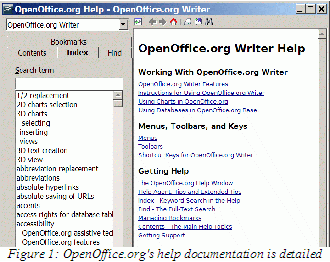
Alternatively, clicking the
![]() icon allows you to explore the features of OpenOffice.org. The
documentation is surprisingly clear and detailed.
icon allows you to explore the features of OpenOffice.org. The
documentation is surprisingly clear and detailed.
Finally, if you prefer to read the instructions in a book rather than on a computer screen, I have recommended several in the examples that follow. Happy reading.
OpenOffice.org – www.openoffice.org
StarOffice – www.sun.com/staroffice
Example OpenOffice.org CD site (USA) – www.getopenoffice.org
Example OpenOffice.org CD site (UK) – www.8daysaweek.co.uk
“OOoSwitch” by Tamar E Granor. Hentzenwerke Publishing 2003. ISBN 1-930919-36-0.
GNU/Linux User Groups – www.linux.org/groups
United Nations International Open Source Network – www.iosn.net
IOSN book site – www.iosn.net/education/foss-education-primer
“Freedom of the press is guaranteed only to those who own one.” — A. J. Liebling
Every ten years, as part of the US Census Bureau's counting of voters, the results from a questionnaire by the National Endowment for the Arts are also collated.
These results5 are regularly quoted in the press as showing that Americans are reading less than ever before. Of course they might be, because they have more TV, more radio, more films and now more computer games than ever before. All these media are competing for every citizen's limited time.
What often goes unmentioned, however, is the amount of writing that Americans do. In 2003, the USA broke another publishing record, producing over 175,000 books. (The UK broke its own, with almost 120,000). And of course, there are more people writing websites than ever before.
Go on – join the revolution and write something.
Examples
Shrub's switching success (page 15)
Ms Yates's templates (page 16)
M. Braille teaches typing (page 17)
Mr Salah Al-Din spell checks and keeps track of reviewer corrections (page 19)
Dr Digitalis creates PDF documents (page 22)
Mr Big's staff use macros to automate common tasks (page 24)
 For
most of the staff at the Mayor of London's office, the switch to
OpenOffice.org was painless. They could open all of their old
Microsoft Office documents and were soon creating new OpenOffice.org
files.
For
most of the staff at the Mayor of London's office, the switch to
OpenOffice.org was painless. They could open all of their old
Microsoft Office documents and were soon creating new OpenOffice.org
files.
The few staff who had difficulties were actually the more experienced Microsoft Word users. They regularly used Word's more advanced features and OpenOffice.org Writer places these features in different parts of the program.
However, they found “OOoSwitch”6 to be a very useful book. As the title promised, the book showed them how to use all those advanced Microsoft Office features in OpenOffice.org. But its question and answer format (e.g. “How do I leave white space between paragraphs?”) meant that finding that information was quick and easy.
In fact the staff found the bite-size format made it enjoyable to learn about other features that they had not been aware of in Microsoft Office (e.g. “How do I put multiple columns in a document?”) and they taught these to their colleagues.
 The
first text file that Ms Yates created was a letter requesting a
manufacturing quote. She had identified four companies that could
produce the high quality prototypes she needed. The letter contained
a list of her requirements and requests for the costs, time frames
and samples.
The
first text file that Ms Yates created was a letter requesting a
manufacturing quote. She had identified four companies that could
produce the high quality prototypes she needed. The letter contained
a list of her requirements and requests for the costs, time frames
and samples.
Because she had bought the StarOffice version of OpenOffice.org Writer, she could use its templates. These made writing the letter quick and easy. They are available from the File menu's Templates and Documents item.
Writer offers a choice of letter styles and she picked an understated professional one. Writer then asked for the address of the recipient and the address that Ms Yates wanted to quote. It placed both at the top of the letter. The recipient's address would appear through the envelope's window once the page was folded.
Ms Yates was also able to insert her
company's logo at the top of the page by clicking on the
![]() icon.
icon.
When listing her requirements, she
clicked the
![]() icon so that a bullet point appeared at the start of every line in
her list. When she finished the list, she clicked the
icon so that a bullet point appeared at the start of every line in
her list. When she finished the list, she clicked the
![]() icon again to write normal text without bullet points.
icon again to write normal text without bullet points.
In listing the deadlines for
different stages of production, she clicked the
![]() icon because the order of the deadlines in the list was important.
This meant that the first deadline, on the first line, began with
“1 -”, the second with “2 -” and so
on. When she finished her list she clicked the
icon because the order of the deadlines in the list was important.
This meant that the first deadline, on the first line, began with
“1 -”, the second with “2 -” and so
on. When she finished her list she clicked the
![]() icon again to write normal text without numbers.
icon again to write normal text without numbers.
When the letter was complete she selected Print... from the File menu. She typed “2” in the Number of copies... box, then clicked the OK button. After a few seconds her printer produced two copies of her letter. She kept one copy in her filing cabinet and put the other into an envelope, with the address appearing through the envelope's window.
For the other three manufacturers she
needed the same letter but with different addresses at the top. For
each, she selected the address, pressed the delete key on her
keyboard and typed in the correct address for that manufacturer. Then
she printed one copy by clicking the
![]() icon.
icon.
Writer's Mail Merge Wizard..., available from the Tools menu, is a powerful tool for automating a task like this. It would have allowed Ms Yates to create the letter, select the addresses to which she wanted copies of the letter sent and then have Writer take care of printing each letter with the correct address. Ms Yates would use the feature in the future for mailing adverts to her customers and press releases to her contacts.
However, in this case doing the four addresses manually was faster and soon Ms Yates was on her way to the post office.
 The
children in M. Braille's class were delighted by the computers,
especially when they figured out how to play the card games that come
with Microsoft Windows.
The
children in M. Braille's class were delighted by the computers,
especially when they figured out how to play the card games that come
with Microsoft Windows.
However, getting the children to use OpenOffice.org Writer was much harder as none of the children knew how to type. Writing an essay on the computer took far too long because they did not know their way around the keyboard. M. Braille was worried when he saw some of the children give up in frustration.
M. Braille downloaded and installed Tux Typing from http://tuxtype.sourceforge.net/downlo ad. It is made by Tux4Kids (www.tux4kids.com), an organisation that makes several other educational Free Software tools.
The children loved playing with Tux, the penguin hero of Tux Typing. Tux eats the fish coming down the screen, but only if the letters on the bodies of the fish were correctly typed (see Figure 2).
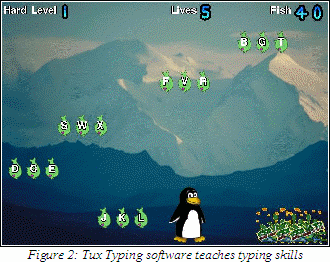
Soon the children began to feed Tux the most fish. At first they typed with one finger on each hand, trying to type as fast as possible. Then they formed teams, with one student covering the right of the keyboard and the other covering the left.
This showed the important role that teachers have to play in the classroom – computers support education, they do not provide it. M. Braille spent a few minutes with each child showing them how to use the left hand for the left side of the keyboard and likewise for the right. He also explained that the fingers should be along the middle row of the keyboard, with the left little finger on the “a” key and the index finger on the “f”. Similarly the right index finger would be on the “j” and the right little finger on the “;”.
At first, this way of typing slowed the children down. But M. Braille encouraged them to persist and soon they were able to beat their previous high scores: they had learnt to touch-type. This skill would serve them well in adulthood as they entered the job market, but in the meantime it allowed them to write all their assignments on the classroom computers.
 As
Mr Salah Al-Din explored the tools in OpenOffice.org Writer, he
created exercises that would improve the students' learning.
As
Mr Salah Al-Din explored the tools in OpenOffice.org Writer, he
created exercises that would improve the students' learning.
First,
he switched off the spelling checker in OpenOffice.org. From the
Tools menu,
he clicked Spellcheck
and then clicked AutoSpellcheck7
until the tick mark (![]() )
disappeared. He knew that he could restart automatic spell checking
by clicking on AutoSpellcheck
again, but for now he wanted to test the students'
own spelling skills.
)
disappeared. He knew that he could restart automatic spell checking
by clicking on AutoSpellcheck
again, but for now he wanted to test the students'
own spelling skills.
He would run dictation exercises with the class on the computer. At the end, he would show them how to run the spelling checker by clicking the Tools menu, then Spellcheck, then Check....
Of course, spelling checkers are not replacements for knowing how to spell correctly and Mr Salah Al-Din wanted to prove this point to the class.
Therefore he asked each student to give a copy of their file to another student and get that student to check the spelling manually. The students found several errors of meaning that automatic spelling checkers cannot find – for example “there” is spelt correctly if you mean the position (“I will look over there”) but incorrectly if you mean the possession (“I will look over their property”).
He
then taught the students how to make the corrections on their
friends' files efficiently. From the Edit
menu, he told them to click on Changes
then Record
until the tick mark (![]() )
appeared. That meant that OpenOffice.org Writer would record every
change made from that point onward. To stop recording at any time the
student just had to click Record
until the tick mark disappeared.
)
appeared. That meant that OpenOffice.org Writer would record every
change made from that point onward. To stop recording at any time the
student just had to click Record
until the tick mark disappeared.
![]()
OpenOffice.org
makes these changes clear on the screen. For example, Figure 3 shows
what happens when the sentence “This is the starting sentence”
is changed to “This is the changed sentence”. The
vertical line on the left-hand side is to show that a change has been
made to that line of text. Both “changed” and “starting”
are in red, meaning that the change concerned those two words on that
line. And the word “changed” is underlined because
it has been added to the text, while “starting”
has a strikethrough to show that it has been deleted.
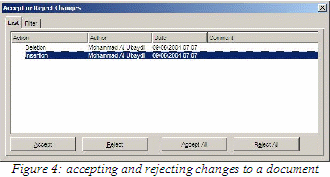
The real fun began when the students returned each file to its original creator. The student could see which changes had been made, but also had the power to accept or reject each one. This feature is available by selecting the Edit menu, then Changes, then Accept or Reject... (see Figure 4). Mr Salah Al-Din used the same feature for his marking of the students' documents.
Mr Salah Al-Din was also able to add notes and comments to the document such as “7/10”, “very good”, or “have you thought about including information about Al-Khawarizmi8 from the Wikipedia?”. This is possible through the Note... command from the Insert menu. A yellow rectangle would appear in the text, (see Figure 5) and moving the mouse on top of that rectangle would show the note to the student.

 OpenOffice.org
provides an excellent tool for distributing completed files. This
feature is not available in Microsoft Word. Dr Digitalis used it to
send posters to the practices of other GPs announcing her launch
party.
OpenOffice.org
provides an excellent tool for distributing completed files. This
feature is not available in Microsoft Word. Dr Digitalis used it to
send posters to the practices of other GPs announcing her launch
party.
In the past she would have designed the poster in Microsoft Word and in fact she began this poster by opening one of her old Microsoft Word files in OpenOffice.org Writer. She then changed the layout and updated the details on the poster.
When the file was ready, however, she clicked Export as PDF... from the File menu. This feature is not present in Microsoft Word and to add it would require buying Adobe Acrobat, with prices starting from $299 on top of the cost of Microsoft Word itself. OpenOffice.org Writer creates PDF files free of charge.
PDF is an abbreviation of Portable Document Format, which hints as to its advantages. It makes your file (the “Document”) easily transferable (“Portable”) to any other computer. Adobe is the company that created the PDF standard. They originally did so to guarantee to graphic designers that files created on their own computers would look exactly the same on the computer of a printing company.
This was important to Dr Digitalis. In the past, when she had given her Word documents to a printing company, she would have to spend some time at the printer's office double-checking that the pages came out as she had wanted them. Often, in moving from her own computer to the printer's, the layout was slightly changed by a fraction of an inch. That fraction could mean that the final printout looked amateurish and careless. If she found such changes, she would have to spend more time at the printer's computer fixing them.
PDF made her confident that she did not need to spend that time. She just emailed the PDF file to her printing office, asked that 500 copies be printed and came by the next day to pick up the pages. These pages looked exactly as she had wanted.
PDF also made the process of emailing easier. A Microsoft Word or OpenOffice.org Writer file can quickly grow in size as more and more amendments are made. This is because the software keeps track of those changes to allow you to reverse them. However, when including the file in an email to the printer, such changes are not useful and the large file size becomes a problem. PDF documents are much smaller in size, making them great for email.
And so Dr Digitalis was also able to email the documents to her GP colleagues. In time, the posters that she had printed off would arrive in her colleagues' surgeries through the mail, but she knew that they would appreciate having the email reminder.
The GPs were able to open and view the file because almost every computer today comes with Adobe Reader9 (www.adobe.com/acrobat). This opens any PDF file and Dr Digitalis's poster appeared on her colleagues' computer screens exactly as she had intended it to.
Furthermore, the PDF file did not include anything that she did not want to appear. For example, if she had sent a Microsoft Word file her colleagues could have found out that her poster had originally been an advertisement for her old car.
Nor do PDF files allow changes to be made by the recipient of the file. This is crucial for clinicians. It would be terrible if Dr Digitalis had sent a Microsoft Word file that recommended drug dosages and one of the recipients accidentally deleted a decimal point from one of them. And it would be disastrous if that person then forwarded the amended document to others, because those recipients would have the wrong dosage and because they would think it had come from Dr Digitalis.
For all of these reasons, you should
use PDF when sharing completed OpenOffice.org files. This feature,
also accessible through the
![]() icon, is available in all OpenOffice.org tools, including Writer,
Impress and Calc.
icon, is available in all OpenOffice.org tools, including Writer,
Impress and Calc.
 OpenOffice.org
can be customised using OpenOffice.org Basic, a programming language.
Like Microsoft Office's Visual Basic, it allows the fast creation of
small programs to automate short sequences of tasks.
OpenOffice.org
can be customised using OpenOffice.org Basic, a programming language.
Like Microsoft Office's Visual Basic, it allows the fast creation of
small programs to automate short sequences of tasks.
For Mr Big's IT team members, the most important factor in making the switch to OpenOffice.org was their ability to customise it. The extraordinary flexibility of Microsoft's Office software has always been important for businesses and Mr Big's company was no exception.
For example, Mr Big's software developers wanted to create a macro that allowed a receptionist to print off a customer's bill. The macro would ask the receptionist for the name of the customer, then automatically get the amount of money that the customer owed, create a letter in OpenOffice.org Writer that included the customer's name and billing amount and print two copies of that letter.
OpenOffice.org makes this possible because it includes tools to connect to any database and because most of OpenOffice.org Writer's tasks (such as creating a letter) can be controlled with the OpenOffice.org Basic language.
This language is not the same as Microsoft Office Visual Basic, but it is similar. Mr Big's IT staff were able to quickly convert their old Microsoft Office macros into macros that did the same job in OpenOffice.org.
OpenOffice.org's help documentation covers this well. For tricky parts, they read the book “OpenOffice.org Macros Explained”10.
But it is not just programmers who can create macros. The Record Macro command from the Tool menu allowed Mr Big to create a macro simply by using OpenOffice.org Writer. The software kept track of the actions that Mr Big took until he clicked the Stop Recording button. In this way he was able to create a macro that he called “PrintTwoCopies”. This would print two copies of his document every time he selected it from the Tools menu.
TuxType – http://tuxtype.sourceforge.net/
Tux4Kids – www.tux4kids.com
Wikipedia – www.wikipedia.org
Adobe Acrobat and Adobe Reader – www.adobe.com/acrobat
“OpenOffice.org Macros Explained” by Andrew Pitonyak. Hentzenwerke Publishing 2004. ISBN 1930919514.
During the 1940s the US military was making full use of “computers”. These were nothing like the small machines that you and I are used to, nor even the room-sized machines that IBM had originally sold to the US census back in 1890. Rather, “computers” were people, usually young men and women with undergraduate degrees in science and mathematics11.
Each “computer” would spend each day performing long and laborious computations, thankfully with the assistance of calculating machines. Each computation could answer questions about the outcome of a scenario.
OpenOffice.org Calc gives you more computational power than a whole roomful of these patient “computers”. It is an example of a spreadsheet, software that has transformed accounting and business planning. The rest of this chapter discusses peaceful uses of a spreadsheet.
At its most basic a spreadsheet like Calc allows you to create a table with column headings, rows of data and colourful formatting to enhance the presentation. If you want to create a beautiful table for your paper brochure, OpenOffice.org Calc may be your best starting point.
However, every number you enter into the table is a number the spreadsheet can use for calculations. Sums, averages, extrapolations, deviations, integrations and differentials – computers compute and Calc is your personal computing slave.
And a spreadsheet brings life to its tables. If you change one number at the top of a table, the outcomes of all the calculations further down the table also change. For example, to find out what would happen to your profits if you decreased the unit price by 10% but increased sales by 20%, change the unit price and sale price in the table. Almost as soon as you finish typing Calc will show you the outcome for profits. This makes Calc a powerful tool for planning.
Finally, Calc creates graphs from your tables’ data: pie charts, line graphs, histograms and scatter plots are just a few of the options that Calc gives you.
Examples
M. Braille creates a simple and secure table of pupil attendance (page 28)
Mr Salah Al-Din sums and sorts (page 30)
Dr Digitalis creates graphs of her patient surveys (page 31)
Ms Yates copys and pastes chart from Calc into her Writer text documents (page 32)
Mr Big and conditional forecasting (page 33)
Mrs Shrub imports data and learns from the US Census (page 33)
 M.
Braille maintained a record of pupil attendance in a large book. The
book served its purpose but he wondered if he could do better with
OpenOffice.org Calc.
M.
Braille maintained a record of pupil attendance in a large book. The
book served its purpose but he wondered if he could do better with
OpenOffice.org Calc.
The program is well-suited to tables because its default display is of many rows and many columns. Down the left-most column he typed in the names of each of the pupils. Across the top row he typed in the first date of the new school year and then the second date.
He used Calc's automatic filling feature for the remaining days. First, he selected both dates. Calc displayed these in white text over a black background to indicate that they were selected and a thick black square appeared in the bottom right-hand corner to indicate that automatic filling was possible (see Figure 6).
![]()
He clicked on the square and dragged it to the right. When he let go of the mouse button, part of the row that he had dragged over was automatically filled with consecutive dates (see Figure 7). Automatic filling is a powerful feature and several sophisticated options are available in OpenOffice.org Calc through the Fill item of the Edit menu.
![]()
Calc provides many features for formatting the tables. M. Braille selected the top row and the left-hand column and changed their background colour to grey. For days on which a student was absent, he changed the background colour of that cell to red. It was easy to see at a glance the attendance of any class or student over the year.
M. Braille wanted to use one file for all his students in any one year. He made use of the sheets to divide each file by class. The sheets of a file are listed in the bottom left-hand corner of the screen (see Figure 8). He renamed each sheet by clicking on it with the right mouse button and selecting Rename sheet....

Finally, because he was keeping so much information in one file, M. Braille wanted to ensure its security. When saving the file he ticked the box Save with password and clicked Save. Once he had filled out the password, Calc encrypted the file. This meant that, for all intents and purposes, the contents of the file could only be read by someone who entered the correct password to open the file.
 Mr
Salah Al-Din used OpenOffice.org to store his students' test marks.
He created a table with the name of each student in the left-hand
column and the date of each test in the top row. He wrote the test
scores in the intersecting cells.
Mr
Salah Al-Din used OpenOffice.org to store his students' test marks.
He created a table with the name of each student in the left-hand
column and the date of each test in the top row. He wrote the test
scores in the intersecting cells.
In the left-hand column, beneath the name of the last student, he typed in “Average”. The rest of the row would contain the average score of the students on each test. This analysis is easy because scores are numbers and Calc has many tools for running calculations on numbers.
After marking the first test of the year he filled an entire column with test scores. He clicked inside the blank cell just below this list of scores, which was on the same row as the “Average” heading.
Then he clicked the
![]() icon to start the Function Wizard.
He selected AVERAGE
from the lengthy list of functions and clicked the
Next button.
He then indicated to Calc the cells that contained the data to be
averaged by clicking on the first score and dragging down to the last
one to highlight all the numbers in the column. He clicked the OK
button and the average appeared instantly.
icon to start the Function Wizard.
He selected AVERAGE
from the lengthy list of functions and clicked the
Next button.
He then indicated to Calc the cells that contained the data to be
averaged by clicking on the first score and dragging down to the last
one to highlight all the numbers in the column. He clicked the OK
button and the average appeared instantly.
For subsequent tests he entered the scores in the columns to right, but he did not need to use the Function Wizard again. Instead he selected the first average, clicked on the thick square that appeared in the bottom right hand corner and dragged to the right. The automatic filling of Calc took care of the rest, using the same AVERAGE function on the data to the right.
Finally, Calc is good for sorting text and numbers. Mr Salah Al-Din highlighted all the cells in his table and selected Sort... from the Data menu. First he sorted using the left-hand column, ordering the tests by the names of the students; he printed that page off. Then he sorted again, this time using the column of the latest test's data. He printed that off to give the students their rankings.
 Every
patient that consulted Dr Digitalis filled out a satisfaction survey
that she had prepared. Her secretary entered the data from the paper
survey into OpenOffice.org Calc.
Every
patient that consulted Dr Digitalis filled out a satisfaction survey
that she had prepared. Her secretary entered the data from the paper
survey into OpenOffice.org Calc.
Dr Digitalis could then analyse the data and create charts.
To create a graph, click in the
top left corner of the data and drag down to the bottom right corner,
ensuring that column and row headings are included in your selection.
Click on the
![]() icon, select the area of your chart, and Calc will show you the
AutoFormat Chart
dialogue.
icon, select the area of your chart, and Calc will show you the
AutoFormat Chart
dialogue.
The chart type of which Dr Digitalis was most fond was the pie chart – she used this at monthly team meetings to show the proportion of patients who found the care it received to be less than acceptable. When she had collected data over many months she used line charts to show trends over time. Bar charts are good for comparing data from groups of patients, while XY charts show the relationship between two variables, such as waiting time and satisfaction.
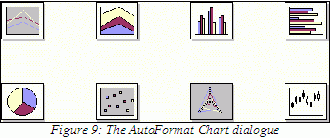
A chart created by Calc automatically uses the original table row and column headings for its labels. You can edit individual elements by double-clicking on them. For example, clicking twice on a slice of a pie chart allows you to change its colour. Likewise doing so on the x-axis of an XY chart changes its scale and the increments of its tick marks.
 Because
OpenOffice.org is so well integrated you can use Calc charts in any
other OpenOffice.org document. Click on a chart, select Copy
from the Edit
menu, switch to your other document and select
Paste from
its Edit menu.
Because
OpenOffice.org is so well integrated you can use Calc charts in any
other OpenOffice.org document. Click on a chart, select Copy
from the Edit
menu, switch to your other document and select
Paste from
its Edit menu.
In researching her business plan Ms Yates collected a lot of data about the market, her customers, and competitors. She stored these data in Calc and made several charts to support her arguments.
She used this to incorporate charts into the Writer document of her business plan. The greyscale PDF that she printed for her bank manager illustrated her findings. She used the same charts in the Impress presentations to venture capitalists and the pie charts were projected in their colourful glory.
 Calc
supports scenario planning: changing the data in one cell changes the
data in all the other cells and charts that depend on that cell. As
Mr Big began his career as an accountant, he still loved a good
spreadsheet document because of this feature.
Calc
supports scenario planning: changing the data in one cell changes the
data in all the other cells and charts that depend on that cell. As
Mr Big began his career as an accountant, he still loved a good
spreadsheet document because of this feature.
For example, changing the revenue from one of his company's hotels changed the total for the region that contained the hotel and the total of all the regions.
The change impacted charts as well. For example, in the pie chart showing a region's contribution to revenues, that region's portion decreased and the other regions' portions increased in size. Mr Big and his team could immediately see the impact of changing costs and revenues on the affected charts.
Calc offers some powerful and subtle tools for the tabular data. For example, using Conditional Formatting... from the Format menu you can set a cell to appear red if its value is negative and black otherwise. Making this cell the sum of revenues and costs for the hotels in a region makes it immediately apparent when changing the revenues leads to losses for the region.
The Tools menu's Goal Seek... item allows the reverse – Mr Big could set the target value for that cell and then calculate the revenues necessary from the hotels that contributed to the value of that cell.
 Mrs
Shrub liked the US Census website (www.census.gov).
Like the best of US government websites it makes as much of its data
publicly available as possible. She wanted to create a similar site
for the statistics collected by London's government.
Mrs
Shrub liked the US Census website (www.census.gov).
Like the best of US government websites it makes as much of its data
publicly available as possible. She wanted to create a similar site
for the statistics collected by London's government.
Like the UK's Census site12, the US site is impressively interactive with maps generated on the fly to illustrate data of any subset.
More significantly, its data were available for download and she could use these in OpenOffice.org. Of course Microsoft Excel files opened instantly in Calc and many of the business data were available in this format.
Other statistics were available in CSV format. This is simpler than Excel’s but it is an open standard that is fully supported by all spreadsheet software, including Excel and Calc.
Finally, other data were available in dBase format. OpenOffice.org includes Base, a database tool, that is capable of handling a whole range of database formats. Although Mrs Shrub had no interest in these files, she understood that businesses and citizens' organisations would benefit from having access to the data for their own analysis and integration.
“Supergenius” by B Bruce-Briggs. North American Policy Press 2000.
The US Census – www.census.gov
The UK Census – www.statistics.gov.uk/census2001/
Dr Whitfield Diffie is one of the few computer scientists to receive erotically-charged fan mail. His best known contribution to the world of computing is the co-invention of a method for protecting secrets electronically: public-key cryptography.
What is less well known is that he created the first presentation software. His program inspired his colleague Bob Gaskins to create PowerPoint13.
Microsoft eventually bought PowerPoint. On over 250 million computers around the world businessmen, teachers, officials, clinicians, professionals and citizens are using PowerPoint to make their point.
Impress is the OpenOffice.org equivalent.
Examples
M. Braille uses existing PowerPoint files (page 36)
Ms Yates creates a simple presentation and uses the StarOffice gallery (page 37)
Dr Digitalis creates a lecture handout (page 38)
Mrs Shrub creates animations and organisational charts (page 39)
Mr Big adds corporate logos and colours using the slide master (page 41)
Mr Salah Al-Din shares his presentations with other teachers (page 43)
 Around
the world, many teachers use PowerPoint to support their lessons. And
many of them make their PowerPoint files available for other teachers
to use. In fact Microsoft's own site provides a whole range of
materials (www.microsoft.com/Education/).
Around
the world, many teachers use PowerPoint to support their lessons. And
many of them make their PowerPoint files available for other teachers
to use. In fact Microsoft's own site provides a whole range of
materials (www.microsoft.com/Education/).
OpenOffice.org Impress can open all these files. M. Braille found that for each particular lesson he could take elements from the lesson plans of several other teachers.
He could Copy entire slides that he liked and Paste them into his own Impress presentation. By choosing Slide Sorter from the View menu the order of the slides can be changed. The text can be changed by double-clicking on the slide containing it. Finally, the Layouts part of the Tasks pane on the right-hand side allows changing the layout of each slide (see Figure 10).
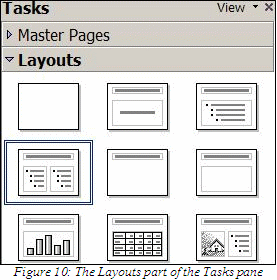
 Creating
a new Impress document is easy. You can select OpenOffice.org
Impress from the Start
menu. Alternatively, within any OpenOffice.org
file (including a text or spreadsheet document) you can select New
from the File
menu and then Presentation.
To create a new slide, select Slide...
from the Insert
menu.
Creating
a new Impress document is easy. You can select OpenOffice.org
Impress from the Start
menu. Alternatively, within any OpenOffice.org
file (including a text or spreadsheet document) you can select New
from the File
menu and then Presentation.
To create a new slide, select Slide...
from the Insert
menu.
However, OpenOffice.org does not contain many templates, nor are the included graphics as slick as those in Microsoft PowerPoint.
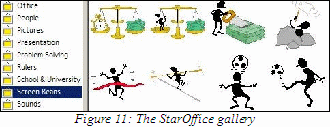
This is why Ms Yates was so
pleased with having paid for StarOffice. It has many useful templates
and a gallery of graphics. Within every application in OpenOffice.org
the Gallery can
be reached through the Tools
menu, or by clicking on the
![]() icon. The gallery of StarOffice has hundreds of useful graphics,
including maps, icons and the infamous screenbean characters (see
Figure 11).
icon. The gallery of StarOffice has hundreds of useful graphics,
including maps, icons and the infamous screenbean characters (see
Figure 11).
 Dr
Digitalis read “The Cognitive Style of PowerPoint”14.
This 28-page essay is by the wonderful Professor Edward Tufte, who
teaches courses in statistical evidence at Yale University. The essay
is highly critical of “slideware” like PowerPoint and
Impress:
Dr
Digitalis read “The Cognitive Style of PowerPoint”14.
This 28-page essay is by the wonderful Professor Edward Tufte, who
teaches courses in statistical evidence at Yale University. The essay
is highly critical of “slideware” like PowerPoint and
Impress:
Alas, slideware often
reduces the analytical quality of presentations. In particular, the
popular PowerPoint templates (ready-made designs) usually weaken
verbal and spatial reasoning, and almost always corrupt statistical
analysis. What is the problem with PowerPoint? And how can we improve
our presentations?
One of the points that Tufte stresses is the importance of a good handout for sharing data with the audience. Showing the data on “slideware” limits the audience's ability to digest the data, while a detailed handout complements the overview that good slides can give.
OpenOffice.org has several
features for creating handouts. First, there is the Handout
Page, available from the View
menu in Impress. This automatically includes
reduced versions of each slide on a page with space left over for
providing extra notes about the slides. The
![]() icon at the bottom of the screen allows text to be added.
icon at the bottom of the screen allows text to be added.
Second, because OpenOffice.org is so well integrated, you can Copy and Paste text, tables and charts from Writer and Calc. You can also do the reverse: create the handout in Writer, then Copy and Paste each slide from Impress into your text document.
Finally, the Handout Page in Impress automatically includes a header and footer area. In these Dr Digitalis put the title of her lecture, her name and the website address of her clinic. She knew that her detailed handouts would be so useful that they would be shared with other clinicians.
 Creating
slideshows is not all that Impress is good for. The Drawing
toolbar (see Figure 12) at the bottom of the
window has many tools for creating shapes, colouring them in and
connecting them.
Creating
slideshows is not all that Impress is good for. The Drawing
toolbar (see Figure 12) at the bottom of the
window has many tools for creating shapes, colouring them in and
connecting them.
For example, clicking the
![]() icon allows the insertion of basic shapes like rectangles, ovals and
rings. The Line and Filling
toolbar at the top of the page allows alteration
of the border line and filling colour of a shape. And double-clicking
on a shape allows you to write inside it.
icon allows the insertion of basic shapes like rectangles, ovals and
rings. The Line and Filling
toolbar at the top of the page allows alteration
of the border line and filling colour of a shape. And double-clicking
on a shape allows you to write inside it.
![]()
These tools allowed Mrs Shrub to mock up quickly a neat diagram of anything that she wanted. She was able to show the website designer the elements she wanted displayed on the London government's website homepage, the layout of the staff newsletter, a birthday card for her sister and the organisation chart for her department.
The chart was particularly easy
to create because of the Connector
tool (![]() )
in the Drawing
toolbar. This draws connecting lines between any
two shapes. Impress correctly redraws each line every time one of the
shapes it was connected to is moved.
)
in the Drawing
toolbar. This draws connecting lines between any
two shapes. Impress correctly redraws each line every time one of the
shapes it was connected to is moved.
Mrs Shrub brought her organisational diagrams to life using the animation feature of Impress.
Like Layouts, this is also available from the Tasks pane on the right hand side (see Figure 13). By clicking on Custom Animation you can Add... and Remove effects for each item of each slide.
For shapes representing employees lower in the hierarchy Mrs Shrub selected the Basic effect called Appear. The rectangle would appear during her slideshow when she pressed the spacebar.
For employees whom she wanted to single out for praise, she chose the Fly In effect and made the shape levitate from the bottom of the screen. She was always careful, however, to avoid too many animation effects, or effects that were too jarring. A classy lady, she did not need Tufte to tell her that less is more when it comes to the special effects of slideware.
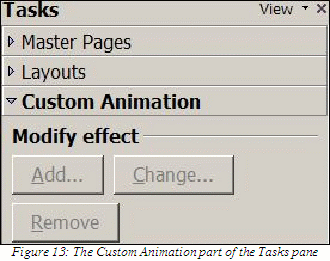
 Impress
has two features to ensure that different slides have the same
background, logos and corporate theme. This was important for Mr Big
and his executives as they give many lectures at industry
conferences.
Impress
has two features to ensure that different slides have the same
background, logos and corporate theme. This was important for Mr Big
and his executives as they give many lectures at industry
conferences.
First, the Slide Master is available from the View menu. Changing any element in this view changes all of the elements in the Normal view (see Figure 14). For example, by changing the background to match the orange and amber colours of the logo of Mr Big's hotel chain, the background in every single slide was changed. And pasting the logo in the top left corner of the master slide made it appear in the top left corner of every slide.
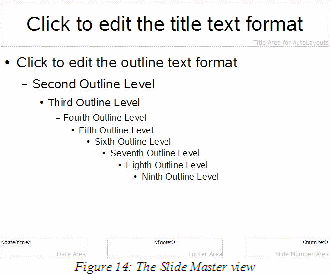
Furthermore, changing the size of the writing in the style of each Outline Level changes the size of that writing in every slide. Using this Mr Big changed the default typeface from Albany to Tahoma, his favourite.
The second important feature is saving the file as a template (see Figure 15) through the File menu's Save As... dialogue. The company made the template file available to all of its employees.
Whenever an OpenOffice.org template is opened, it creates a new file with the same default settings as the template. In other words, Mr Big's executives would begin their Impress presentations by opening the template. All their slides would have the company's background, logo and typeface. Mr Big loved consistency.

 Like
M. Braille, Mr Salah Al-Din used Impress extensively in his lessons.
However, he liked to make his files available to others through the
school website. This was good for students who had missed his lessons
through illness. He also shared the files with other teachers to save
their time and to allow improvements to the lesson plans.
Like
M. Braille, Mr Salah Al-Din used Impress extensively in his lessons.
However, he liked to make his files available to others through the
school website. This was good for students who had missed his lessons
through illness. He also shared the files with other teachers to save
their time and to allow improvements to the lesson plans.
The Save As... dialogue of Impress (see Figure 15) offers several options, including Microsoft PowerPoint presentation and Microsoft PowerPoint template formats. For sharing on the web there are several useful read-only formats. Like OpenOffice.org Writer these are available through the Export... dialogue of the File menu. The PDF format is useful for emailing copies of a lesson that would be printed, while HTML is useful for including the lesson in a website. Finally, the Marcomedia Flash format is good for playing the slides on a website.
The next part of this book will cover the internet and some of the many Free Software tools that will help you create your own website. But I will finish this part with a reminder of just how much OpenOffice.org can do for you.
“Absolute
PowerPoint” by Ian Parker. New Yorker, May 28th
2001. A copy is available
at:
www.physics.ohio-state.edu/~wilkins/group/powerpt.html
Microsoft education resources – www.microsoft.com/Education/
“The Cognitive Style of PowerPoint” by Edward Tufte. Graphics Press 2003. ISBN 0961392150.
“If all you have is a hammer, everything looks like a nail.” Anonymous
In 1891 Victorinox began supplying the Swiss Army with pocket knifes. The company now produces over 22,000 Swiss Army knives per day most of which are for export. Around the world many people have come to depend on these knives for their versatility.
OpenOffice.org is even more versatile. In this chapter I hope to give you some ideas that show off more of its abilities.
I wrote this book using OpenOffice.org Writer. Many features made the software an excellent choice. For example, the Indexes and Tables... command automatically generated the table of contents for the book. As I added, deleted and reorganised chapters, Writer adjusted the table of contents and kept track of the page numbers.
The command also created the index at the back of the book. All I had to do was identify individual ideas as important enough to include in the index using the Entry... command.
As the book increased in size I decided to divide it into separate files for faster loading and easier backing up. I used the Master Document command to create a single file that collated the other files. Writer automatically renumbered the pages, figure captions and entries in the table of contents and index across all of these files.
I exported the result into a single PDF file. I could provide this to any printer and be sure that the output would be exactly as I had intended. I had done this using Microsoft Word and Adobe Acrobat when I wrote and published my first book, “Handhelds for Doctors”15.
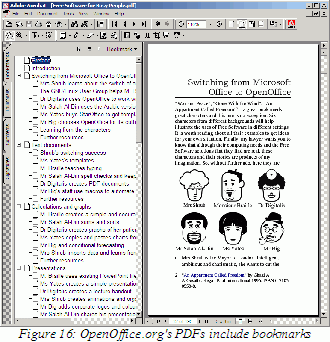
What impressed me with OpenOffice.org was that the exported PDF included Adobe Reader-compatible features like Bookmarks. This adds a professional touch to the electronic book and makes for a pleasant reading experience. Doing this with Word and Acrobat is difficult and time-consuming but Writer handled the job beautifully and automatically (see Figure 16).
Academic authors will also appreciate Writer’s formulae and bibliography features. The Formula feature is powerful, allowing the insertion and manipulation of many mathematical symbols.
Unlike Word, Writer also includes a bibliography manager, accessible as the Bibliography Database from the Tools menu. This feature is particularly worth watching, as with the release of Version 2 of OpenOffice.org development of more advanced bibliographic tools has begun16.
In fact the release of this version also heralds development of lots of other tools because OpenOffice.org is built on XML17. For software developers and enterprises this means a transparent foundation on which to build quickly extensions. For you and me it means a wealth of more powerful tools is on the way.
But enough about text – OpenOffice.org can also handle drawings.
Impress is surprisingly good for layout design. The Toolbars submenu from the View menu lists several useful toolbars. These include the Drawing toolbar that appears at the bottom of the screen by default, but also the 3D-Objects, Circles and Ovals, and other toolbars. On a blank slide with no layout you can use all the text, shapes and colours that you need for your drawing.
OpenOffice.org Draw is a more specialised tool that has no equivalent in Microsoft Office. You can access it by choosing New then Drawing from the File menu.
Use the Page... command from the Format menu to select a different layout for the page. For example, you can choose a much larger page for a poster, or a square one for a birthday card.
When your drawing is finished, the Export... command will create something appropriate for your publication medium. For the large poster example, PDF is what your printer will expect from you. If you are publishing for the web the HTML Document option creates a web page while the PNG option creates an image that you can use in other web pages.
You can use any of your OpenOffice.org Draw documents in any of your other OpenOffice.org documents. This even works in OpenOffice.org Base.
The most significant improvement in OpenOffice.org 2.0 is the addition of Base because it allows you to create databases.
A database is an electronic version of a filing cabinet containing paper forms. Like the filing cabinet you can use it to store the forms for safe keeping, and see the data entered in each form whenever you need. You can also add more data by completing a new form and adding it to the store.
But because it is electronic, a database has many advantages over filing cabinets. First, it sorts the data quickly and in as many ways as you want it to. For example, you can sort a database of your friends’ birthdays by the last name of each of them, or their birthday, or both. The forms can also be faster to complete. For example, a database form with addresses can include a drop-down list of countries. Choosing from these can be faster than writing the country name. More importantly, you can guarantee that everyone who fills out the form will have spelt the country correctly because they chose from your correctly spelt list.
With a little programming, Base can be very powerful. For example, when the user types in the zip code the database can automatically deduce the city and state.
The programming aspect means that most of us will leave the design of databases to someone with formal computer training. What you need to tell this member of your team is that Base is a relational database with Forms and Reports, that it can connect to any ODBC datasource, including MySQL databases and that it handles SQL queries.
In other words, Base matches Microsoft Access in features, but is available free of charge.
Meanwhile, what you need to know is that Base is powerful and useful. Whenever you find yourself and your team filling out a form more than a few times, think of using Base. Whether you want to store your church’s membership, your clients’ addresses, your patients’ cancer diagnoses, or your city residents’ property tax valuations, consider using Base as part of the solution.
I hope that by now you have understood some of the power of OpenOffice.org and the implications of having this power free of charge. The next part will show you that such power and price is available in many other examples of Free Software.
OpenOffice.org Bibliographic Project – http://bibliographic.openoffice.org/
OpenOffice.org XML – http://xml.openoffice.org/
1“An Appartment Called Freedom” by Ghazi A AlGosaibi. Kegan Paul International 1996. ISBN 0-7103-0550-8.
2“LiMux – The Linux Migration of the City of Munich” – www.suse.de/en/company/press/services/information/linux/limux.html.
3“OOoSwitch: 501 Things You Wanted to Know About Switching to OpenOffice.org from Microsoft Office” by Tamar E Granor. Hentzenwerke Publishing 2003. ISBN 1-930919-36-0.
4“Free / Open Source Software Education Primer” – www.iosn.net/education/foss-education-primer.
5“Reading At Risk: A Survey of Literary Reading in America” – www.nea.gov/pub/ReadingAtRisk.pdf. National Endowment for the Arts, Research Division Report #46.
6“OOoSwitch: 501 Things You Wanted to Know About Switching to OpenOffice.org from Microsoft Office” by Tamar E Granor. Hentzenwerke Publishing 2003. ISBN 1-930919-36-0.
7Of course, because the students were using the Arabic version of OpenOffice.org, they actually clicked the أدوات menu, then دقق الإملاء and أوتوماتيكياً. The software included an Arabic spelling checker.
8Abu Abdullah Muhammad bin Musa al-Khawarizmi was a Persian scientist, mathematician and author born around 780 AD. He developed the concept of an algorithm in mathematics and is thus sometimes given the title “grandfather of computer science”. To learn more, see http://en.wikipedia.org/wiki/Al-Khawarizmi
9Adobe Reader is not Free Software, but it is free of charge. There are Free Software alternatives, but for now consider Adobe Reader good enough.
10“OpenOffice.org Macros Explained” by Andrew Pitonyak. Hentzenwerke Publishing 2004. ISBN 1930919514.
11This story is taken from page 16 of the book “Supergenius” by B Bruce-Briggs. North American Policy Press 2000. The book is the biography of one such “computer”, Herman Kahn, who went on to found the Hudson Institute.
13A
fascinating history of PowerPoint appeared in The New Yorker's
May 28th 2001 issue. Written by Ian Parker, “Absolute
Power point” is well worth the read
at:
www.physics.ohio-state.edu/~wilkins/group/powerpt.html
14“The Cognitive Style of PowerPoint” by Edward Tufte. Graphics Press 2003. ISBN 0961392150.
15This was the self-published edition of the book that was eventually published by John Wiley & Sons, Ltd, under the title “Handheld Computers for Doctors”.